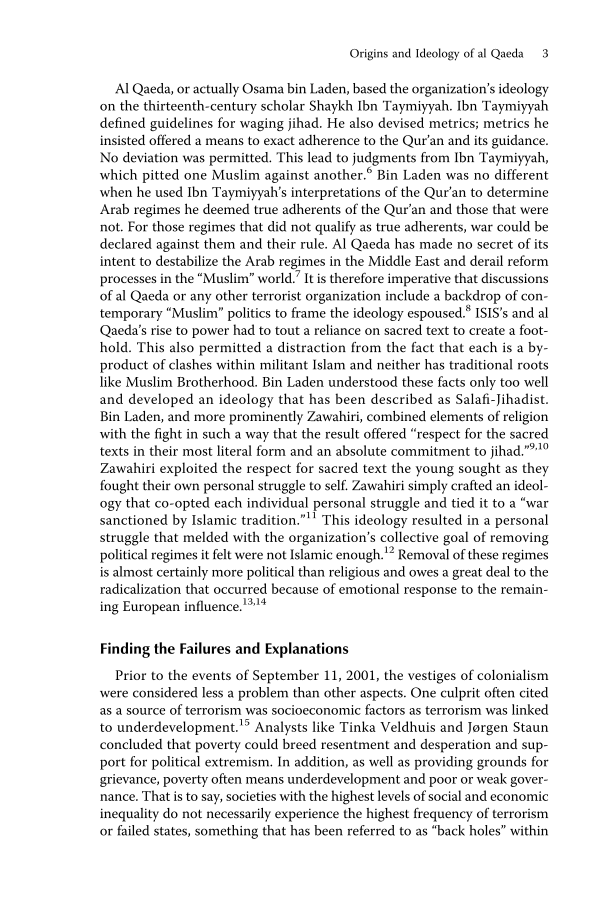Al Qaeda, or actually Osama bin Laden, based the organization’s ideology on the thirteenth-century scholar Shaykh Ibn Taymiyyah. Ibn Taymiyyah defined guidelines for waging jihad. He also devised metrics metrics he insisted offered a means to exact adherence to the Qur’an and its guidance. No deviation was permitted. This lead to judgments from Ibn Taymiyyah, which pitted one Muslim against another.6 Bin Laden was no different when he used Ibn Taymiyyah’s interpretations of the Qur’an to determine Arab regimes he deemed true adherents of the Qur’an and those that were not. For those regimes that did not qualify as true adherents, war could be declared against them and their rule. Al Qaeda has made no secret of its intent to destabilize the Arab regimes in the Middle East and derail reform processes in the “Muslim” world.7 It is therefore imperative that discussions of al Qaeda or any other terrorist organization include a backdrop of con- temporary “Muslim” politics to frame the ideology espoused.8 ISIS’s and al Qaeda’s rise to power had to tout a reliance on sacred text to create a foot- hold. This also permitted a distraction from the fact that each is a by- product of clashes within militant Islam and neither has traditional roots like Muslim Brotherhood. Bin Laden understood these facts only too well and developed an ideology that has been described as Salafi-Jihadist. Bin Laden, and more prominently Zawahiri, combined elements of religion with the fight in such a way that the result offered ‘‘respect for the sacred texts in their most literal form and an absolute commitment to jihad.”9,10 Zawahiri exploited the respect for sacred text the young sought as they fought their own personal struggle to self. Zawahiri simply crafted an ideol- ogy that co-opted each individual personal struggle and tied it to a “war sanctioned by Islamic tradition.”11 This ideology resulted in a personal struggle that melded with the organization’s collective goal of removing political regimes it felt were not Islamic enough.12 Removal of these regimes is almost certainly more political than religious and owes a great deal to the radicalization that occurred because of emotional response to the remain- ing European influence.13,14 Finding the Failures and Explanations Prior to the events of September 11, 2001, the vestiges of colonialism were considered less a problem than other aspects. One culprit often cited as a source of terrorism was socioeconomic factors as terrorism was linked to underdevelopment.15 Analysts like Tinka Veldhuis and Jørgen Staun concluded that poverty could breed resentment and desperation and sup- port for political extremism. In addition, as well as providing grounds for grievance, poverty often means underdevelopment and poor or weak gover- nance. That is to say, societies with the highest levels of social and economic inequality do not necessarily experience the highest frequency of terrorism or failed states, something that has been referred to as “back holes” within Origins and Ideology of al Qaeda 3
Document Details My Account Print multiple pages
Print
You have printed 0 times in the last 24 hours.
Your print count will reset on at .
You may print 0 more time(s) before then.
You may print a maximum of 0 pages at a time.









































































































































































































































































